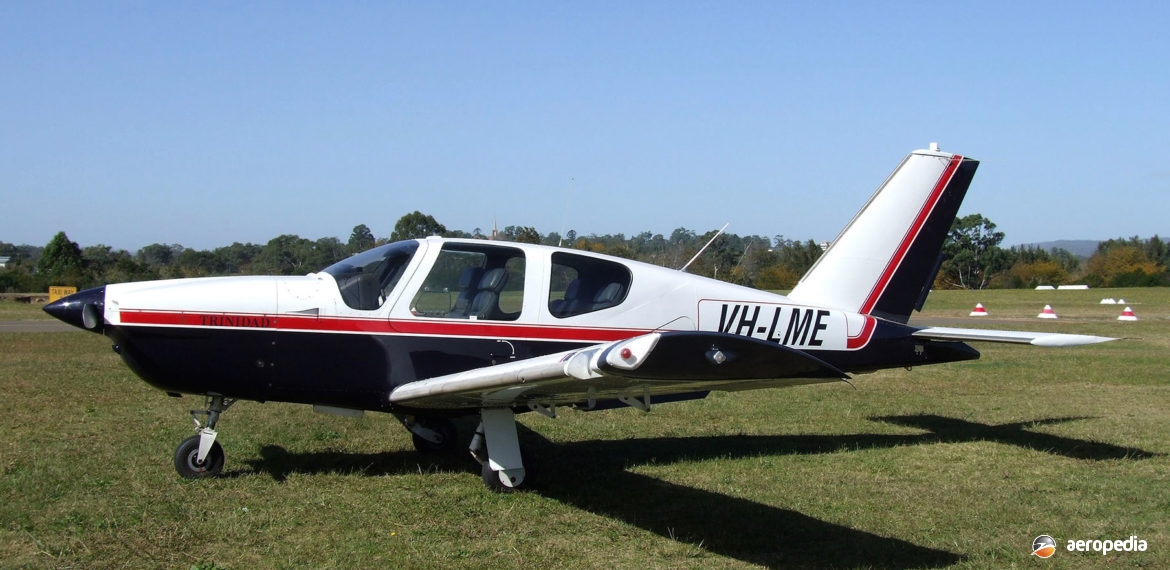Photograph:
Socata TB-20 Trinidad VH-LME (c/n 959) at Camden, NSW in May 2007 (David C Eyre)
Country of origin:
France
Description:
Four-seat cabin touring monoplane
Power Plant:
One 187 kw (250 hp) Avco Lycoming IO-540-C4D5D six-cylinder horizontally-opposed air-cooled engine
Specifications:
- Wingspan: 9.8 m (32 ft 1¾ in)
- Length: 7.7 m (25 ft 3⅛ in)
- Height: 2.9 m (9 ft 6 in)
- Wing area: 11.90 m² (128.1 sq ft)
- Max speed: 312 km/h (193 mph)
- Max cruising speed at 75% power: 303 km/h (188 mph)
- Economical cruising speed at 65% power at 3,660 m (12,000 ft): 296 km/h (184 mph)
- Initial rate of climb: 384 m/min (1,260 ft/min)
- Range with 45 mins reserves at 75% power: 1,640 km (1,019 miles)
- Range at economical cruising speed at 65% power: 1,785 km (1,109 miles)
- Empty weight: 776 kg (1,710 lb)
- Loaded Weight: 1,332 kg (2,937 lb)
History:
The TB-20 Trinidad was designed by Socata, a subsidiary of Aerospatiale, as a natural up-market development of the popular TB-10 Tobago but fitted with a retractable undercarriage and a 187 kw (250 hp) Lycoming engine, having an increased fuel capacity. The prototype of the TB-20 was flown for the first time on 14 November 1980, certification being obtained in 1982, and deliveries to customers commenced later that year. As with the other aircraft in the Socata series, the cabin was larger than most aircraft in this class and was said to be wider than a lot of twin-engined aircraft. Accommodation was provided for four and, with a maximum usable fuel load of 326 litres (71.7 Imp gals) and 30 kg (68 lb) of baggage, the aircraft cruised at 303 km/h (188 mph) at 75% power for 1,640 km (1,019 miles) with 45 minutes reserves.
In 1984 the TB-20 was up-dated, the max take-off weight being increased to 1,400 kg (3,086 lb) but the landing weight remaining at 1,335 kg (2,943 lb). In early 1986 the TB-20 Trinidad TC appeared, this being a turbocharged model with a 187 kw (250 hp) Avco Lycoming TIO-540-AB1AD engine, providing a cruising speed at 75% power at 7,620 m (25,000 ft) of 346 km/h (215 mph) for a range of 1,648 km (1,024 miles). A further up-date in 1990 from the 950th aircraft completed involved strengthening of the undercarriage and installation of a 20 volt electrical system. In April 1999 the TB-20 BG or Nouvelle Generation appeared, the name later being changed to GT or Generation Two, the first production model being produced in February 2000.
A number of examples have been registered in this region. The manufacturer later became known as EADS Socata and produced the aircraft in two models, the TB 20 GT and TB 21 GT Turbo, stating ”We build each TB-series aircraft (more than 2,000 now) for the utmost comfort on long-distance legs. A good thing considering that range is more than 1,000 nm. We also build them to last and retain a high resale value. Indeed, the Trinidad’s durability (think single-piece machined aluminium spar), easy maintainability and factory support are central to long-term value retention.”
The Trinidad GT had 20% of its airframe made of composites and the cabin was re-modelled with new flush-mounted Plexiglas windows and a larger luggage door. Some attention was also given to improving the aerodynamics, with new wing tips, a new fin strake and retractable footsteps. New modern-designed three-blade propellers were available, and later the Trinidad, like the rest of the series, became available with diesel engines ranging in power from 134 kw (180 hp) to 224 kw (300 hp). One engine which has been tested was a four-cylinder horizontally-opposed compression ignition turbocharged diesel engine running on JET A1 produced by Morane Renault Sport, the 186 kw (250 hp) unit being 6 kg (13 lb) lighter than the IO-540 engine.

